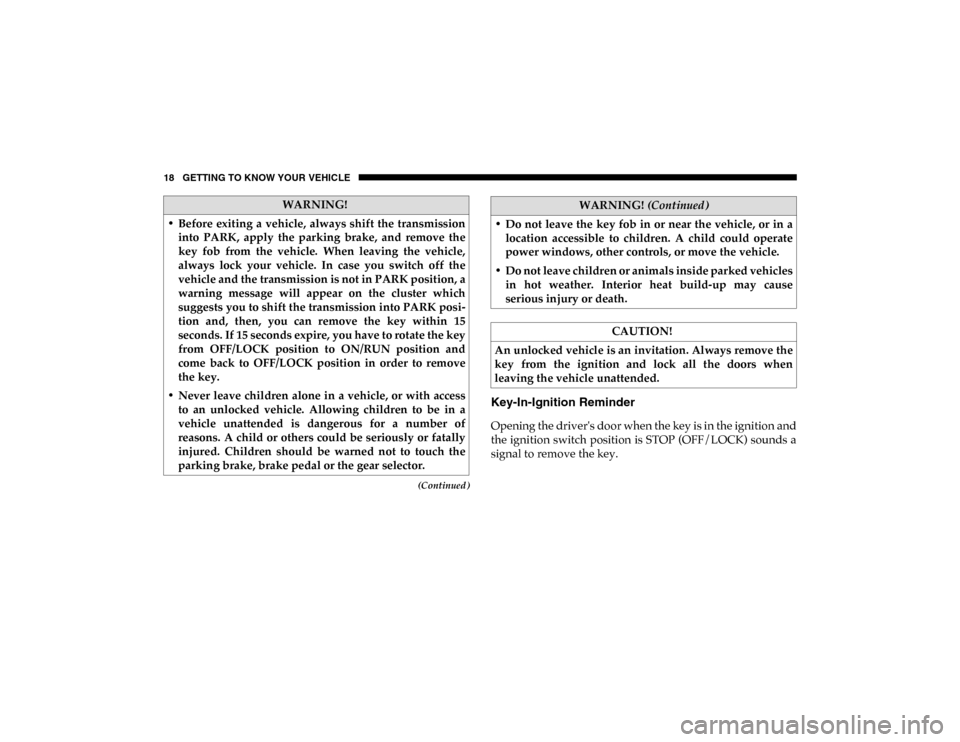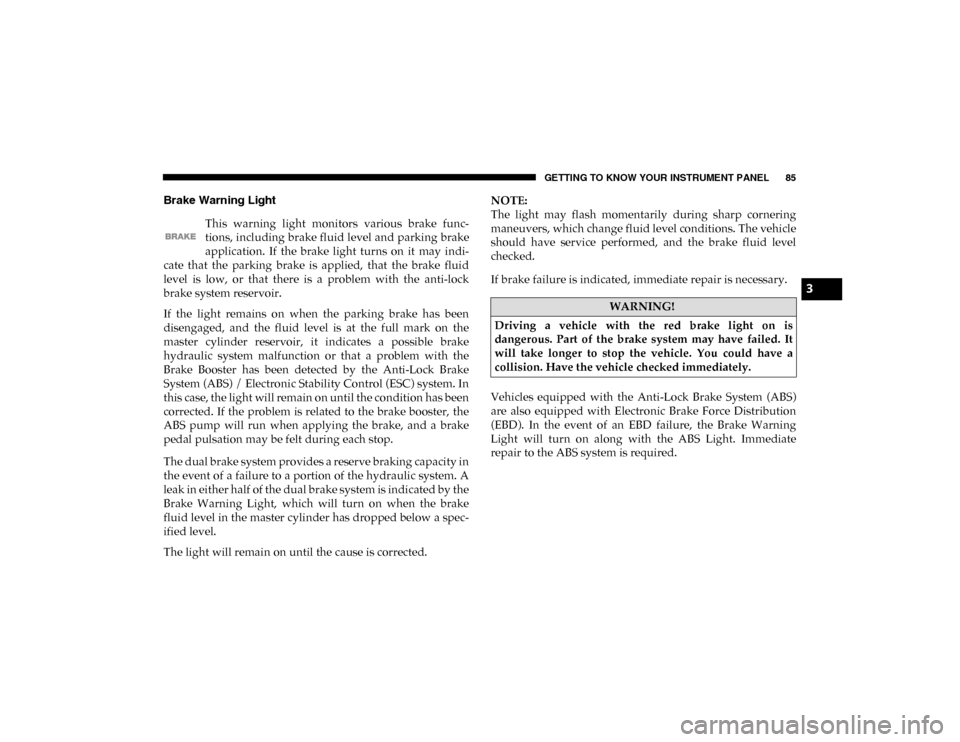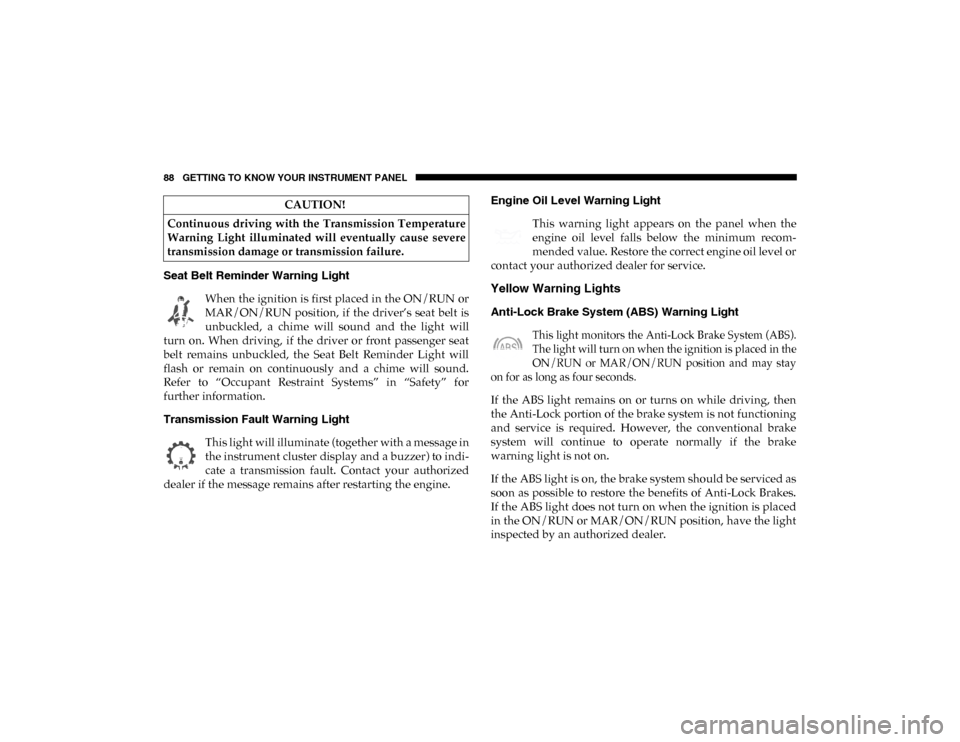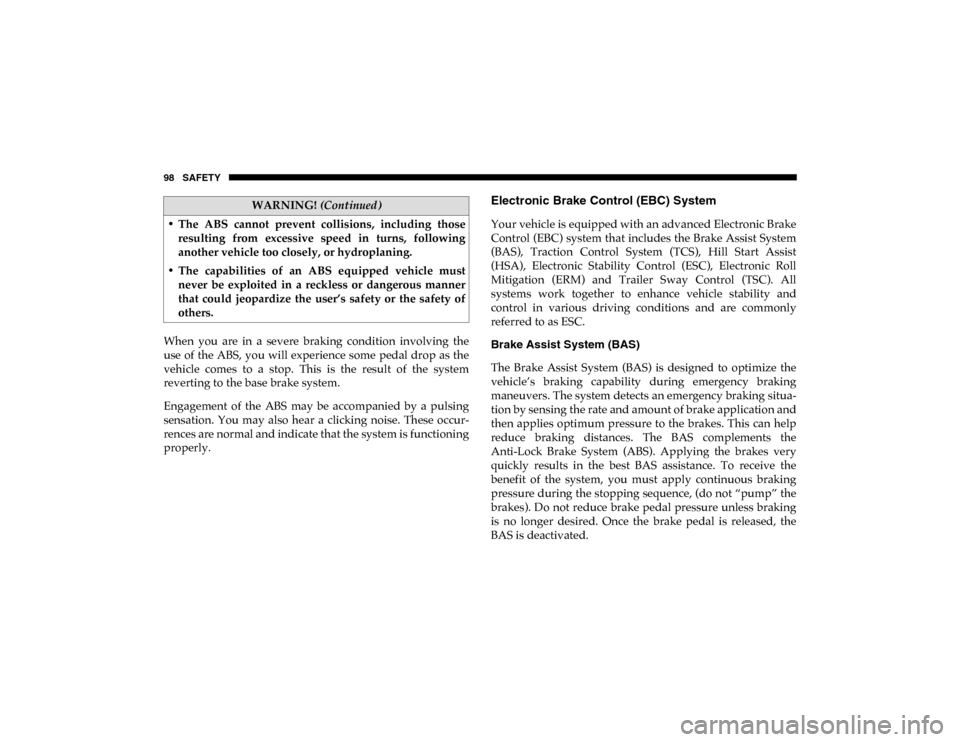brake Ram ProMaster City 2020 Owner's Manual
[x] Cancel search | Manufacturer: RAM, Model Year: 2020, Model line: ProMaster City, Model: Ram ProMaster City 2020Pages: 350, PDF Size: 13.27 MB
Page 7 of 350

4
WARNING LIGHTS AND MESSAGES .......................... 84
Red Warning Lights ...................................................... 84
Yellow Warning Lights................................................. 88
Green Indicator Lights .................................................. 92
Blue Indicator Lights ..................................................... 93
ONBOARD DIAGNOSTIC SYSTEM — OBD II ............. 94
Onboard Diagnostic System (OBD II)
Cybersecurity ................................................................. 94
EMISSIONS INSPECTION AND MAINTENANCE
PROGRAMS ....................................................................... 95
SAFETY
SAFETY FEATURES ........................................................... 97
Four-Wheel Anti-Lock Brake System (ABS) ............ 97
Electronic Brake Control (EBC) System .................... 98
AUXILIARY DRIVING SYSTEMS .................................. 103
Tire Pressure Monitoring System (TPMS) ............. 103
OCCUPANT RESTRAINT SYSTEMS ........................... 108
Occupant Restraint Systems ...................................... 108
Important Safety Precautions .................................... 108
Seat Belt Systems ........................................................ 109
Supplemental Restraint Systems (SRS) .................... 120
Child Restraints ......................................................... 133
Transporting Pets ..................................................... 153
SAFETY TIPS ...................................................................153
Transporting Passengers ............................................153
Exhaust Gas ..............................................................153
Safety Checks You Should Make Inside
The Vehicle ..................................................................154
Periodic Safety Checks You Should Make Outside
The Vehicle ...................................................................156
STARTING AND OPERATING
STARTING THE ENGINE ..............................................157
Automatic Transmission.............................................157
Normal Starting ........................................................... 157
Cold Weather Operation ...........................................158
Extended Park Starting ...............................................158
If Engine Fails To Start ..............................................158
After Starting ................................................................159
ENGINE BLOCK HEATER — IF EQUIPPED .............159
ENGINE BREAK-IN RECOMMENDATIONS ............160
PARKING BRAKE ........................................................... 161
AUTOMATIC TRANSMISSION ....................................163
Key Ignition Park Interlock ........................................164
Brake/Transmission Shift Interlock System ............164
Nine-Speed Automatic Transmission ......................164
2020_RAM_PROMASTER_CITY_OM_USA=GUID-7B6A7FCA-79B0-423F-95C5-ED2A949C3D13=1=en=.book Page 4
Page 10 of 350

7
DEALER SERVICE ........................................................... 248
Engine Oil ................................................................... 248
Engine Oil Filter ......................................................... 250
Engine Air Cleaner Filter ......................................... 250
Air Conditioner Maintenance ................................. 251
Body Lubrication ....................................................... 252
Windshield Wiper Blades ......................................... 252
Exhaust System ........................................................... 253
Cooling System .......................................................... 255
Brake System ............................................................... 260
Power Steering Fluid................................................... 261
Automatic Transmission ........................................... 261
Upfitter Connectors — If Equipped.......................... 263
RAISING THE VEHICLE ............................................... 266
TIRES................................................................................... 266
Tire Safety Information ............................................ 266
Tires — General Information .................................... 276
Tire Types ..................................................................... 282
Spare Tires — If Equipped ....................................... 283
Wheel And Wheel Trim Care ................................. 285
Tire Chains (Traction Devices) ................................. 287
Tire Rotation Recommendations ............................... 287
DEPARTMENT OF TRANSPORTATION UNIFORM
TIRE QUALITY GRADES ...............................................288
Treadwear .....................................................................288
Traction Grades............................................................ 289
Temperature Grades ................................................... 289
STORING THE VEHICLE .............................................289
BODYWORK ......................................................................290
Protection From Atmospheric Agents ....................290
Body And Underbody Maintenance .........................290
Preserving The Bodywork .......................................... 291
INTERIORS .......................................................................292
Seats And Fabric Parts ................................................292
Plastic And Coated Parts ............................................292
Leather Parts.................................................................293
Glass Surfaces ..............................................................293
2020_RAM_PROMASTER_CITY_OM_USA=GUID-7B6A7FCA-79B0-423F-95C5-ED2A949C3D13=1=en=.book Page 7
Page 11 of 350

8
TECHNICAL SPECIFICATIONS
IDENTIFICATION DATA ............................................... 294
Vehicle Identification Number .................................. 294
BRAKE SYSTEM................................................................ 295
WHEEL AND TIRE TORQUE SPECIFICATIONS ..... 295
Torque Specifications .................................................. 295
FUEL REQUIREMENTS ................................................ 297
2.4L Engine ................................................................... 297
Reformulated Gasoline ............................................ 297
Gasoline/Oxygenate Blends ..................................... 297
E-85 Usage In Non-Flex Fuel Vehicles ..................... 298
CNG And LP Fuel System Modifications ................ 298
MMT In Gasoline......................................................... 298
Materials Added To Fuel............................................ 299
Fuel System Cautions.................................................. 299
Carbon Monoxide Warnings .................................... 300
FLUID CAPACITIES ..................................................... 301
FLUIDS AND LUBRICANTS .......................................... 302
Engine ......................................................................... 302
Chassis ....................................................................... 304
MULTIMEDIA
UCONNECT SYSTEMS ................................................... 305
CYBERSECURITY ............................................................305
UCONNECT SETTINGS .................................................306
Uconnect 3/3 NAV Settings.......................................307
STEERING WHEEL AUDIO CONTROLS —
IF EQUIPPED .................................................................... 317
Radio Operation........................................................... 317
Media Mode..................................................................317
IPOD®/USB/MP3 CONTROL — IF EQUIPPED ...... 318
RAM TELEMATICS - IF EQUIPPED..............................318
Ram Telematics General Information .......................319
RADIO OPERATION AND MOBILE PHONES .........320
Regulatory And Safety Information .........................320
UCONNECT VOICE RECOGNITION ..........................322
Introducing Uconnect .................................................322
Get Started .................................................................... 322
Basic Voice Commands...............................................323
Radio..............................................................................324
Media ............................................................................. 325
Phone ............................................................................. 326
Voice Text Reply ..........................................................327
General Information ....................................................327
Additional Information...............................................328
2020_RAM_PROMASTER_CITY_OM_USA=GUID-7B6A7FCA-79B0-423F-95C5-ED2A949C3D13=1=en=.book Page 8
Page 21 of 350

18 GETTING TO KNOW YOUR VEHICLE
(Continued)
Key-In-Ignition Reminder
Opening the driver's door when the key is in the ignition and
the ignition switch position is STOP (OFF/LOCK) sounds a
signal to remove the key.
WARNING!
• Before exiting a vehicle, always shift the transmission into PARK, apply the parking brake, and remove the
key fob from the vehicle. When leaving the vehicle,
always lock your vehicle. In case you switch off the
vehicle and the transmission is not in PARK position, a
warning message will appear on the cluster which
suggests you to shift the transmission into PARK posi -
tion and, then, you can remove the key within 15
seconds. If 15 seconds expire, you have to rotate the key
from OFF/LOCK position to ON/RUN position and
come back to OFF/LOCK position in order to remove
the key.
• Never leave children alone in a vehicle, or with access to an unlocked vehicle. Allowing children to be in a
vehicle unattended is dangerous for a number of
reasons. A child or others could be seriously or fatally
injured. Children should be warned not to touch the
parking brake, brake pedal or the gear selector.
• Do not leave the key fob in or near the vehicle, or in alocation accessible to children. A child could operate
power windows, other controls, or move the vehicle.
• Do not leave children or animals inside parked vehicles in hot weather. Interior heat build-up may cause
serious injury or death.
CAUTION!
An unlocked vehicle is an invitation. Always remove the
key from the ignition and lock all the doors when
leaving the vehicle unattended.
WARNING! (Continued)
2020_RAM_PROMASTER_CITY_OM_USA=GUID-7B6A7FCA-79B0-423F-95C5-ED2A949C3D13=1=en=.book Page 18
Page 63 of 350

60 GETTING TO KNOW YOUR VEHICLE
(Continued)
WINDOWS
Power Windows — If Equipped
Power Window Switch Panel
The control on the left front door panel has up-down
switches that give you fingertip control of all power
windows. There is a single opening and closing switch on the
front passenger door for passenger window control. If the vehicle is equipped with rear power windows, a single
opening and closing switch on the rear passenger doors for
passenger window control is provided.
NOTE:
The key off power delay feature will allow the power
windows to operate for up to three minutes after the ignition
is turned off. This feature is canceled when either front door
is opened.
The window opening mechanism is fitted with sensors that
can detect the presence of an obstacle while the window is
closing. When this happens, the system activates and the
movement of the glass is immediately reversed.
If the presence of an object is detected and the system is acti
-
vated, it may be necessary to perform the reset procedure by
fully opening the windows.
1 — Rear Window Control Buttons (If Equipped)
2 — Driver Passenger Window Control Buttons
3 — Rear Window Lock ButtonWARNING!
• Never leave children alone in a vehicle, or with access to an unlocked vehicle. Allowing children to be in a
vehicle unattended is dangerous for a number of
reasons. A child or others could be seriously or fatally
injured. Children should be warned not to touch the
parking brake, brake pedal or the gear selector.
2020_RAM_PROMASTER_CITY_OM_USA=GUID-7B6A7FCA-79B0-423F-95C5-ED2A949C3D13=1=en=.book Page 60
Page 88 of 350

GETTING TO KNOW YOUR INSTRUMENT PANEL 85
Brake Warning Light This warning light monitors various brake func -
tions, including brake fluid level and parking brake
application. If the brake light turns on it may indi -
cate that the parking brake is applied, that the brake fluid
level is low, or that there is a problem with the anti-lock
brake system reservoir.
If the light remains on when the parking brake has been
disengaged, and the fluid level is at the full mark on the
master cylinder reservoir, it indicates a possible brake
hydraulic system malfunction or that a problem with the
Brake Booster has been detected by the Anti-Lock Brake
System (ABS) / Electronic Stability Control (ESC) system. In
this case, the light will remain on until the condition has been
corrected. If the problem is related to the brake booster, the
ABS pump will run when applying the brake, and a brake
pedal pulsation may be felt during each stop.
The dual brake system provides a reserve braking capacity in
the event of a failure to a portion of the hydraulic system. A
leak in either half of the dual brake system is indicated by the
Brake Warning Light, which will turn on when the brake
fluid level in the master cylinder has dropped below a spec -
ified level.
The light will remain on until the cause is corrected. NOTE:
The light may flash momentarily during sharp cornering
maneuvers, which change fluid level conditions. The vehicle
should have service performed, and the brake fluid level
checked.
If brake failure is indicated, immediate repair is necessary.
Vehicles equipped with the Anti-Lock Brake System (ABS)
are also equipped with Electronic Brake Force Distribution
(EBD). In the event of an EBD failure, the Brake Warning
Light will turn on along with the ABS Light. Immediate
repair to the ABS system is required.
WARNING!
Driving a vehicle with the red brake light on is
dangerous. Part of the brake system may have failed. It
will take longer to stop the vehicle. You could have a
collision. Have the vehicle checked immediately.
3
2020_RAM_PROMASTER_CITY_OM_USA=GUID-7B6A7FCA-79B0-423F-95C5-ED2A949C3D13=1=en=.book Page 85
Page 89 of 350

86 GETTING TO KNOW YOUR INSTRUMENT PANEL
Operation of the Brake Warning Light can be checked by turning
the ignition switch from the OFF position to the ON/RUN posi-
tion. The light should illuminate for approximately two seconds.
The light should then turn off unless the parking brake is applied
or a brake fault is detected. If the light does not illuminate, have
the light inspected by an authorized dealer.
The light also will turn on when the parking brake is applied
with the ignition switch in the ON/RUN position.
NOTE:
This light shows only that the parking brake is applied. It
does not show the degree of brake application.
Battery Charge Warning Light
This warning light will illuminate when the battery
is not charging properly. If it stays on while the
engine is running, there may be a malfunction with
the charging system. Contact an authorized dealer as soon as
possible.
This indicates a possible problem with the electrical system
or a related component. Door Open Warning Light
This indicator will illuminate when one or more
door(s) are not fully closed.
NOTE:
If the vehicle is moving and a door is opened, there will also
be a single chime.
Electronic Throttle Control (ETC) Warning Light This warning light will illuminate to inform of a
problem with the Electronic Throttle Control (ETC)
system. If a problem is detected while the vehicle is
running, the light will either stay on or flash depending on
the nature of the problem. Cycle the ignition when the
vehicle is safely and completely stopped and the transmis -
sion is placed in the PARK (P) position. The light should turn
off. If the light remains on with the vehicle running, your
vehicle will usually be drivable; however, see an authorized
dealer for service as soon as possible.
2020_RAM_PROMASTER_CITY_OM_USA=GUID-7B6A7FCA-79B0-423F-95C5-ED2A949C3D13=1=en=.book Page 86
Page 91 of 350

88 GETTING TO KNOW YOUR INSTRUMENT PANEL
Seat Belt Reminder Warning Light When the ignition is first placed in the ON/RUN or
MAR/ON/RUN position, if the driver’s seat belt is
unbuckled, a chime will sound and the light will
turn on. When driving, if the driver or front passenger seat
belt remains unbuckled, the Seat Belt Reminder Light will
flash or remain on continuously and a chime will sound.
Refer to “Occupant Restraint Systems” in “Safety” for
further information.
Transmission Fault Warning Light
This light will illuminate (together with a message in
the instrument cluster display and a buzzer) to indi -
cate a transmission fault. Contact your authorized
dealer if the message remains after restarting the engine. Engine Oil Level Warning Light
This warning light appears on the panel when the
engine oil level falls below the minimum recom -
mended value. Restore the correct engine oil level or
contact your authorized dealer for service.
Yellow Warning Lights
Anti-Lock Brake System (ABS) Warning Light
This light monitors the Anti-Lock Brake System (ABS).
The light will turn on when the ignition is placed in the
ON/RUN or MAR/ON/RUN position and may stay
on for as long as four seconds.
If the ABS light remains on or turns on while driving, then
the Anti-Lock portion of the brake system is not functioning
and service is required. However, the conventional brake
system will continue to operate normally if the brake
warning light is not on.
If the ABS light is on, the brake system should be serviced as
soon as possible to restore the benefits of Anti-Lock Brakes.
If the ABS light does not turn on when the ignition is placed
in the ON/RUN or MAR/ON/RUN position, have the light
inspected by an authorized dealer.
CAUTION!
Continuous driving with the Transmission Temperature
Warning Light illuminated will eventually cause severe
transmission damage or transmission failure.
2020_RAM_PROMASTER_CITY_OM_USA=GUID-7B6A7FCA-79B0-423F-95C5-ED2A949C3D13=1=en=.book Page 88
Page 100 of 350

97
(Continued)
SAFETY
SAFETY FEATURES
Four-Wheel Anti-Lock Brake System (ABS)
The Four-Wheel Anti-Lock Brake System (ABS) is designed
to aid the driver in maintaining vehicle control under
adverse braking conditions. The system operates with a
separate computer to modulate hydraulic pressure, to
prevent wheel lock-up and to help avoid skidding on
slippery surfaces.
The system's pump motor runs during an ABS stop to
provide regulated hydraulic pressure. The pump motor
makes a low humming noise during operation, which is
normal.
The ABS includes an amber ABS Warning Light. When the
light is illuminated, the ABS is not functioning. The system
reverts to standard non-anti-lock brakes. Turning the igni-
tion OFF and ON again may reset the ABS if the fault
detected was only momentary.
WARNING!
• The ABS contains sophisticated electronic equipment that may be susceptible to interference caused by
improperly installed or high output radio transmitting
equipment. This interference can cause possible loss of
anti-lock braking capability. Installation of such equip -
ment should be performed by qualified professionals.
• Pumping of the Anti-Lock Brakes will diminish their effectiveness and may lead to a collision. Pumping
makes the stopping distance longer. Just press firmly
on your brake pedal when you need to slow down or
stop.
• The ABS cannot prevent the natural laws of physics from acting on the vehicle, nor can it increase braking
or steering efficiency beyond that afforded by the
condition of the vehicle brakes and tires or the traction
afforded.
4
2020_RAM_PROMASTER_CITY_OM_USA=GUID-7B6A7FCA-79B0-423F-95C5-ED2A949C3D13=1=en=.book Page 97
Page 101 of 350

98 SAFETY
When you are in a severe braking condition involving the
use of the ABS, you will experience some pedal drop as the
vehicle comes to a stop. This is the result of the system
reverting to the base brake system.
Engagement of the ABS may be accompanied by a pulsing
sensation. You may also hear a clicking noise. These occur-
rences are normal and indicate that the system is functioning
properly.
Electronic Brake Control (EBC) System
Your vehicle is equipped with an advanced Electronic Brake
Control (EBC) system that includes the Brake Assist System
(BAS), Traction Control System (TCS), Hill Start Assist
(HSA), Electronic Stability Control (ESC), Electronic Roll
Mitigation (ERM) and Trailer Sway Control (TSC). All
systems work together to enhance vehicle stability and
control in various driving conditions and are commonly
referred to as ESC.
Brake Assist System (BAS)
The Brake Assist System (BAS) is designed to optimize the
vehicle’s braking capability during emergency braking
maneuvers. The system detects an emergency braking situa -
tion by sensing the rate and amount of brake application and
then applies optimum pressure to the brakes. This can help
reduce braking distances. The BAS complements the
Anti-Lock Brake System (ABS). Applying the brakes very
quickly results in the best BAS assistance. To receive the
benefit of the system, you must apply continuous braking
pressure during the stopping sequence, (do not “pump” the
brakes). Do not reduce brake pedal pressure unless braking
is no longer desired. Once the brake pedal is released, the
BAS is deactivated.
• The ABS cannot prevent collisions, including those
resulting from excessive speed in turns, following
another vehicle too closely, or hydroplaning.
• The capabilities of an ABS equipped vehicle must never be exploited in a reckless or dangerous manner
that could jeopardize the user’s safety or the safety of
others.
WARNING! (Continued)
2020_RAM_PROMASTER_CITY_OM_USA=GUID-7B6A7FCA-79B0-423F-95C5-ED2A949C3D13=1=en=.book Page 98